
MARIALINDEN & ENGELSKIRCHEN
Travelling from Aachen and around the "Koeln Ring" motorways by car is not for the faint-hearted and it is with some relief that one turns off towards Olpe on the A4 as the road is newer and the traffic diminishes the further away from Cologne that you go. The motorway goes through some amazing scenery in the valley of the Agger east of Overath and from the motorway away to the south on a hill can be glimpsed the twin spires of the church at Marialinden. A little further on to the north, deep in the valley as the autobahn continues to climb towards Olpe, lies the larger town of Engelskirchen, and there is another road that connects the two!
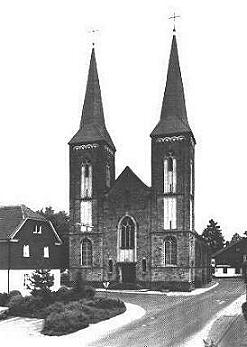
The origins of the church, which is dedicated to The Visitation of the Blessed Virgin Mary, date back to the 15th century when a chapel was built here to serve a hermitage. To this chapel was brought a likeness of the Virgin Mary - a pieta - found nearby in a lime tree( Linden) and this soon became a place of pilgrimage. It is recorded that money was given in 1512 towards the enlargement of the church. It was still a notable place of pilgrimage in 1791 when Pope Pius VI bestowed monies for the celebration mass. In 1811 the roof was destoyed by fire, following a lightning strike. The church was raised to a parish church in 1857 and in1898 the church was enlarged to the west by a further bay and twin steeples were erected. Prior to this the chancel roof was crowned by a baroque turret. The west front seems to have reused features from the original front and has a mixture of Classic and Gothic elements.
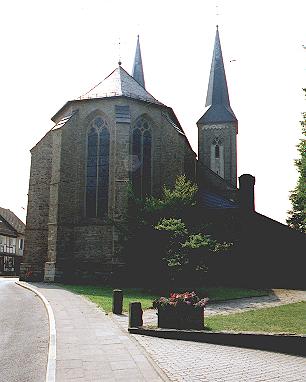
The church stands at the highest point of the village, the road climbs up to the west front and falls away from the east apse. The twin spires suggest a larger, perhaps grander church than actually exists. The whole village is well-kept and the church had its last big restoration completed in Spring 1979.
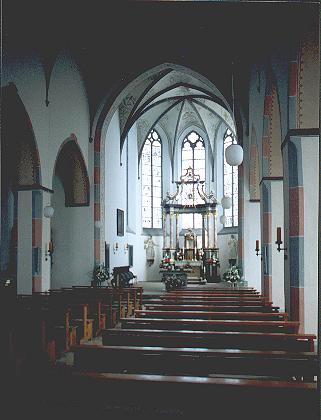
Inside this late C19 west bay has a gallery. To the east a further three bays to nave and aisles, and a two bayed chancel with three sided E apse. All is vaulted in stone and the nave is tall enough to have had a clerestory, but there is blank wall here instead. The arcades have square chamfered piers and ponted unchamfered arches. All windows are of two lights, except the nave west window of three lights, and two smaller windows that light the vestibule below the gallery. No windows in the aisle east walls. The reredos in the N aisle is dated 1626, that in the s aisle is C18 but shelters a pieta of early C16.
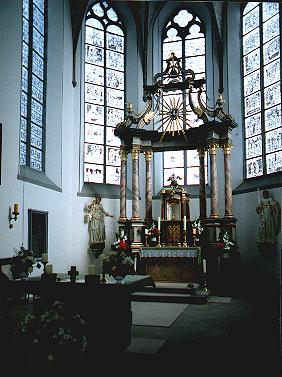
The baldichino in the apse is among the most elegant of its type, tall and finely proportioned, with six Corinthian columns supporting a "crowned" entablature. It is also C18. The picture also shows in the foreground the new main altar of 1979 and the C18 female allegorical figures flanking the baldichino. The vaults have remains of frescoes, in the apse with the symbols of the Evangelists.
After the late medieval and baroque elegance of Marialinden, this church features the other periods, namely Romanesque, neo-Gothic of the C19 and modern architecture. Surprisingly, as you will see, these are blended together successfully.
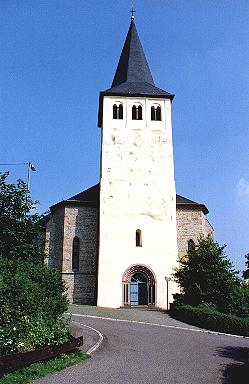
The west tower of the church at Engelskirchen has Romanesque features and resembles that at Much nearby. It is unbuttressed and has three slightly diminishing stages and later bell-stage with triple two-light openings and a short tiled spire. A small round headed light is placed over the doorway. The rest of the church was rebuilt in 1878 and the aisles slightly embrace the tower. It is basically a large rectangle, with side walls having transepts after three bays and with further two bays to the east. Lower narrower five-sided E apse. The aisles end walls are externally "chamfered, and internally have tall lancets in arched recesses. Two-light side windows and four-light transept end windows.
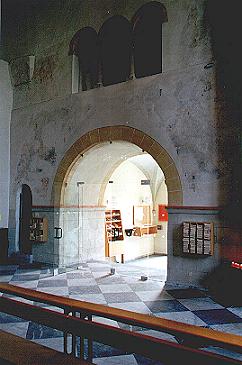
Inside the tower has a low vaulted vestibule and semi circular arch towards the nave. Above this arch is a large triple opening from the upper chamber which is reached by stairs to the south of the arch. At the other end of the church the chancel is flanked by turrets and an ancient door leads to a crypt (locked) - are these also remnants of the medieval church? The rest of the church is a surprise.....
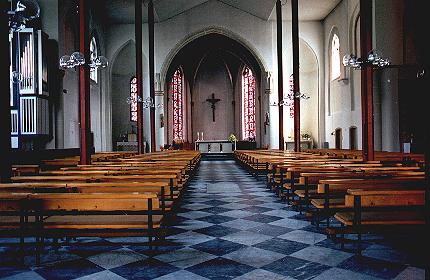
The church was burnt out during the second world war. It was initially restored with a wooden roof replacing the vaults and resting on the former arcades, and was in use again by October 1949. Since then the church has been further altered. In place of the heavy cylindrical pillars and heavy beamed roof, there now stands slim metal piers supporting a concrete ceiling. The responds of the arcades survive at the entrances to the transepts and flanking the arch to the apse. When was this work done and was there a reason for it other than a bold idea for improvement? Was there a fire, or did the arcades become unstable for instance ? Any help on this subject would be appreciated.
As the picture is in black and white, I need to tell you that the piers are painted red and black and the chequer floor is in a dark and light shade of turquoise. The pews are in golden ?beech.